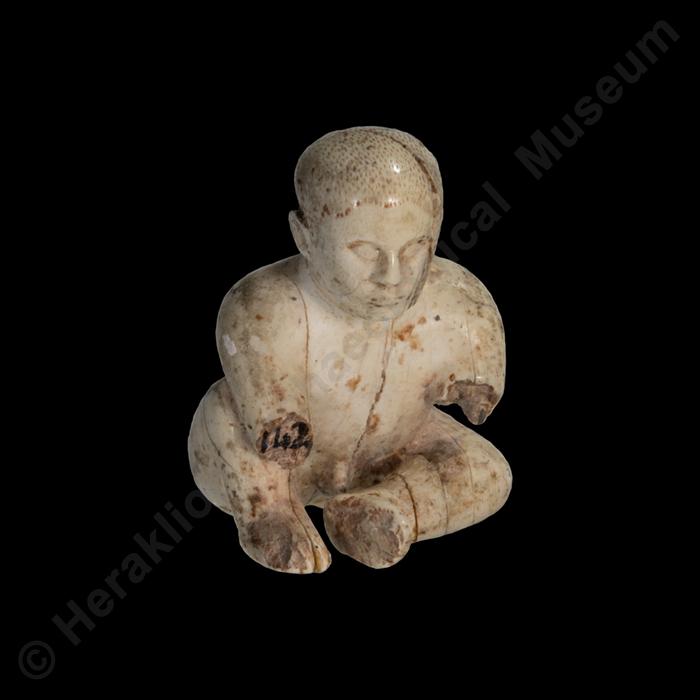Crawling baby figurine
Ο-Ε142
Bone (Ivory)
Good
Height: 4.3 cm.
Palaikastro
Minoan Settlement, Block Σ
Late Bronze Age, Neopalatial period, Late Minoan IB period:
1500 -1450 BC:
Gallery:
VCase:
49Exhibition thematic unit:
Late Bronze Age - Neopalatial period (1700-1450 BC). The New Palaces. The zenith of Minoan civilisationMiniature art
Description
Small figurine of a nude infant, sitting with the left leg bent to the side and the right bent vertically, body leaning forward and hands probably extending towards the floor. The position and angles of the limbs indicate the dynamic movement of a crawling baby rather than that of a calmly seated child. The proportions of the body, limbs and head, with the short, fat neck, plump body and chubby limbs, demonstrate an exceptional naturalistic awareness of the child’s proportions. The stippled scalp indicates either short hair or perhaps a shaven head. This ivory figurine was found with a figurine of a nude standing boy with finer bodily features but a similar “attention to realism” in the proportions of a child of four to five years of age. The figurines may form a group of children set on a single base rather than separate figurines. The minor differentiations in the bodily proportions of the standing child, who has a slimmer torso, thinner neck and more developed occiput, may reflect a difference in age from the smaller crawling child. This distinction may hint at the meaning of the whole scene, the entry to the upright and walking phases of childhood. Despite initial suspicions that these miniature sculptural works originated outside Crete, perhaps in Egypt, today they are considered characteristic works of the Minoan naturalism at its height. This occurred during the final phase of the New Palaces, when Minoan plastic art proved capable of successfully capturing, in hard materials, unprecedented age grades in the depiction of the human body.Bibliography:
Bosanquet, R. C. & R. M. Dawkins, 1923. The Unpublished Objects from the Palaikastro Excavations: 1902 – 1906, Annual of the British School at Athens, Supplementary Papers, No 1, 125 – 27, fig. 107, pl. 27. Hemingway, S., 2000. The place of the Palaikastro Kouros in Minoan bone and ivory carving, in MacGillivray, J.A., J.M. Driessen, and L.H. Sackett. 2000. The Palaikastro Kouros. A Minoan Chryselephantine Statuette and Its Aegean Bronze Age Context. London: The British School at Athens. BSA Studies 6, pp. 113-122, fig. 9.3 d.Author:
D. S.Photographs' metadata
